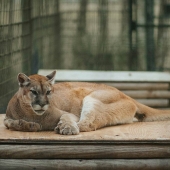COUGAR
Class: Mammalia
Order: Carnivora
Family: Felidae
Species: Puma concolor
Status: Least Concern

These cats, often considered the largest of the “small cats” (all wild cats excluding Leopards, Jaguars, Lions and Tigers) go by five different names in different geographic ranges, including mountain lion (Western United States), panther (South Florida), cougar (British Columbia and Alberta, Canada), puma (Central and South America) and catamount (from Indians seeing the cats atop mountains). As far as we know, all of Catty Shack’s current resident mountain lions are most closely related to Western United States population.
LIFE SPAN
8-13 years in the wild; up to 20 plus years in captivity
DIET
In the wild, mountain lions (or pick your favorite name from above), like most cats, are carnivores. Their diets consist of an array of different size prey, depending on geographic regions, appropriate prey species in those regions, etc. Common meals are elk, deer, sheep, hogs, armadillos, rabbits, rodents, birds and more. At Catty Shack, our mountain lions eat 5-8 pounds of meat five to six nights a week. The Catty Shack Ranch follows the USDA guidelines and feeds according to their body weight. They also follow strict nutrition requirements from their veterinarians and also add vitamins and minerals to all their food. Their menu is primarily chicken and red meat. Catty Shack only feeds processed meats, never live.
SIZE
From nose to end of tail, male mountain lions average over 7 ½ feet in length, while females average roughly 6 ½ feet. Males usually weigh between 110 and 220 pounds and females between 60 and 140 pounds. At Catty Shack, the weight of our mountain lions covers almost that entire range. Their weights are monitored to help ensure they stay healthy.
HABITAT & NUMBERS
Fortunately, unlike some other species of cats, mountain lions have a “least concern” conservation status. Two factors that lead to their success as a species in the wild are range and adaptability. They have a vast, and in many locations, continuous range (from Canada to South America) that allows them to have a strong population. These cats have large home territories that vary from 10-20 square miles to several hundred square miles. They prefer thick vegetation and forests in remote areas, from the Rocky Mountains, to subtropical South Florida, to the jungles of South America. Despite those positive notes, like other large animals, mountain lions are also negatively affected by humans encroaching on and destroying their habitats (they were once prevalent in the Eastern United States too, and their overall population is thought to be steady or declining). The International Union for Conservation of Nature currently estimates a total wild population of roughly 50,000 breeding animals.
REPRODUCTION
Mating is the only time female and male mountain lions socially interact. Although they don’t spend much time together, mating can occur often. In the wild, females average a litter of 2-3 (although 1-6 is possible) cubs every other year. Gestation periods are roughly three months, and births typically occur in dens. Only the females are involved in parenting, which includes protecting and nursing the cubs and teaching the cubs how to be defensive, find shelter and perhaps most important, hunt. Cub survival rate to adulthood is roughly 50%. Cubs remain with their mothers up until 1 ½-2 years old, before moving on to establish their own territories.
OTHER FUN COUGAR FACTS
Mountain lions have a bite pressure of approximately 400 pounds per square inch, not as much as larger lions or tigers, but PLENTY to get the job done.Cubs are born with cute spots (more for camouflage instead of cuteness), but completely grow out of them by about two years old.
Mountain lions have the largest hind legs in the cat family relative to the rest of their body, allowing them to leap 30 feet horizontally from a crouched position and sprint up to 40 miles per hour!
Right here in Florida is the only sub-population of the species surviving east of the Mississippi River. There are only about 150 Florida Panthers left in the wild in South Florida. It’s our state animal, yet needs more protection and preserved habitat now more than ever!
Mountain lion tails are vital to their success in the wild, as they use it as balancing stick when stalking and hunting their prey from above.

